FEAR AND ANGST IN THE VINES IN PROVENCE
by Susan Manfull
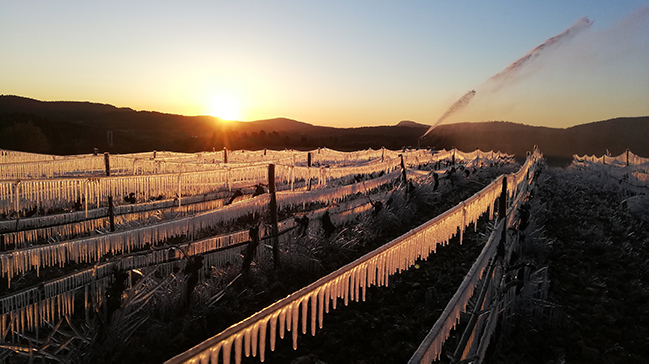 At Château Vignelaure, rotating sprinklers spray water to protect the vines on 0.5 hectares of the 55-hectare property. Photo courtesy of Philippe Bru
At Château Vignelaure, rotating sprinklers spray water to protect the vines on 0.5 hectares of the 55-hectare property. Photo courtesy of Philippe Bru
Vineyards across France were exposed to plummeting temperatures and severe frosts last week, causing massive damage to the vines as well as other crops. The storied regions of Burgundy and Bordeaux may have captured more of the attention from mainstream journalists, but virtually every part of France was affected by temperatures that dipped as low as -8֯ Celsius (17.6֯ Fahrenheit) on as many as three nights. This historic spell of frigid temperatures gripped Champagne, Alsace, Loire, South-West, Languedoc, Rhône Valley, and even sunny Provence. In some vineyards across the country, damage appears to be upwards of 90%.
To say that the impact is catastrophic is not an exaggeration. Agricultural Minister Julien Denormandie has promised the support of the French government for farmers whose crops were adversely affected by this destructive frost. The cost will be staggering. As one winemaker told Provence WineZine, “It will be up to Macron to get his checkbook.”
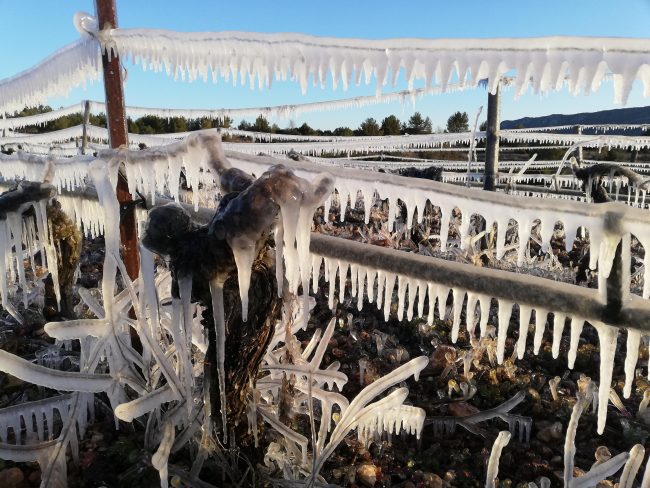
At Château Vignelaure, rotating sprinklers spray water to protect the vines on 0.5 hectares of the 55-hectare property. Photo courtesy of Philippe Bru
Although some winemakers are insured in the case of such catastrophe, I will go out on a frozen vine and guess that most are not; coverage is expensive and, heretofore, such severe acts of nature were considered rare. Vignerons with whom PWZ spoke could count them on one hand. Paraphrasing Philippe Bru, oenologist and winemaker at Château Vignelaure: “Even with insurance and aid from the government, it will nowhere near compensate … the final burden will be on the producers.”
This year, all but the large producers were already reeling from depressed sales due to the COVID-19 pandemic and producers of all sizes were affected by the US tariffs imposed by the Trump administration (temporally lifted by the Biden administration) as well as the various effects on British trade from Brexit. The cost of some of the measures used to try to protect the vines is also quite high (e.g., paraffin-fueled heaters, sprinklers, wind machines, and, in some cases, helicopters). The historic April 2021 frost compounded the fear and angst already felt this year by many people in the wine business.
Provence, a Region of Microclimates
In Provence, the impact of the frost was mixed, undoubtedly reflecting the many microclimates in the region. Some vineyards were not at all affected — because budbreak had not yet occurred — and others were severely affected, expecting a loss as great as 80%. The frigid temperature differentially affected vines on the same property and, as shown in the photo below, where even adjacent buds bore the consequences of the frost differently The frost hit Provence in the early morning hours of Thursday 8 April.
Valérie LeLong, who is responsible for Marketing and Communication for Export at the Conseil Interprofessionnel des Vins de Provence (CIVP), told me that the Chamber of Agriculture is working closely with winemakers to assess the short- and long-term effects of the frost. The analysis will take time, she explained, given the vast territory of the region, the varied typologies of the vineyards, and the different grape varieties, each of which may be affected differently.
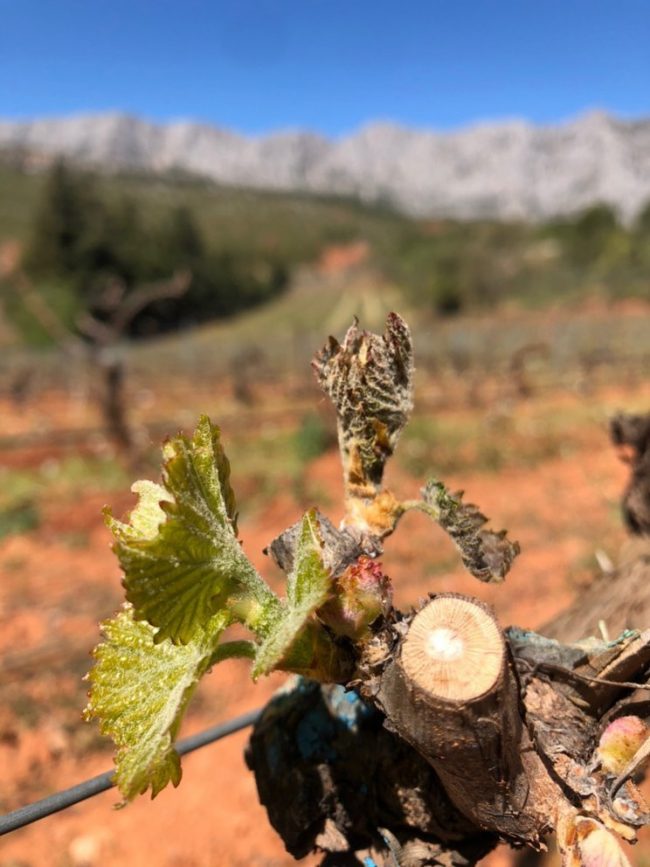
As explained on the Instagram feed of Domaine Richeaume, “The brown, almost black coloring of the young leaves is a consequence of the 8 April frost. The ones on the left look intact while the one on the right has suffered. The sapling, rich in water, froze and ‘burned’ the leaves. In a few weeks, we will know if the vine will reach its fruit stage. At this time, I am surprised to see, just a few centimeters apart, such a difference in color between the buds.” Photo courtesy of Wanda Hoesch
Domaine de la Source, located in the tiny appellation of Bellet in the northern tier of Nice, did not sustain any damage, according to Carine Dalmasso, viticulturist at her family estate. Château Barbebelle, located in Rognes in a relatively sheltered area of the northern part of Coteaux d’Aix-en-Provence, was not affected as budbreak generally occurs later in this area. Due east, at a higher elevation in the same appellation, lies Château Vignelaure; there, significant damage seems to have taken place but Bru said that it was not as bad as it could have been because budding occurs later on his estate.
“It was -7.5֯ C…I’ve never seen anything like this,” Bru said in a telephone call over the weekend. “But it is too early to tell what the real impact will be.”
About 20 kilometers south of Château Vignelaure, at the foot of Mont Sainte-Victoire, is Domaine Richeaume in Puyloubier,in Côtes de Provence. Sylvain Hoesch, winemaker and owner, acknowledged that the vineyard had been hit by the frost but said that any damage was not too serious.
“Fortunately, we pruned very long and the [frost damaged] buds will be replaced by the ones which did not open,” Hoesch explained, adding “Let’s see in two weeks.”
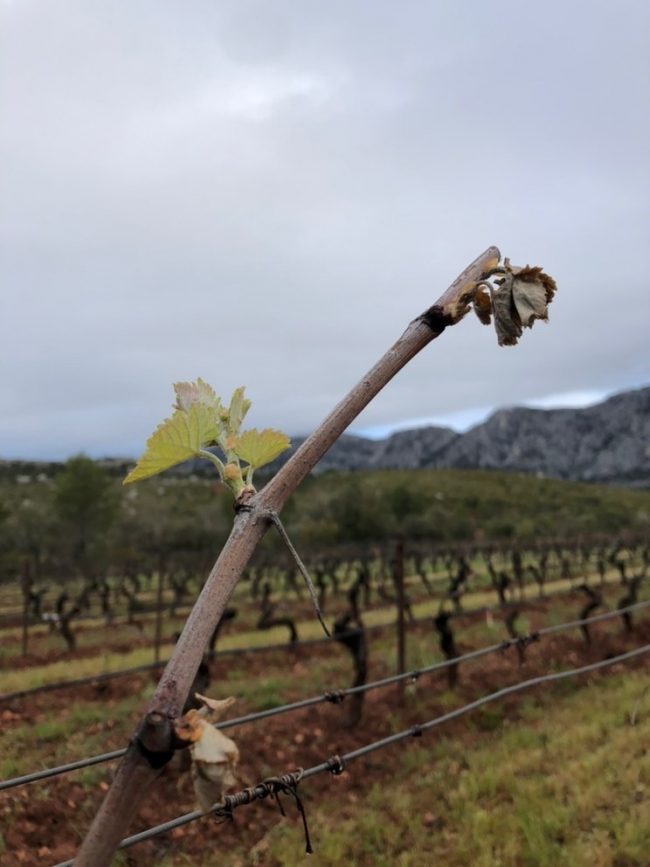
At Domaine Richeaume, Sylvain Hoesch said that pruning was “very long,” part of a double-pruning approach. Photo courtesy of Wanda Hoesch
Further south and 70 kilometers east of Domaine Richeaume, still in Côtes de Provence, is Domaine de l’Amaurigue. There, the impact of the frost was “very severe – as much as 80% — but it is too early to tell for sure,” according to Jean-Marie Quef, director and oenologist of the estate. Budbreak had begun.
Every winemaker we were able to reach stressed that it was too early to determine the extent of the damage. Another two to four weeks is needed to see what can be salvaged. In general, the mood was not optimistic – for the region, in general, and, in some cases, for their own vineyard. All expressed dismay about the devastation of the frost throughout the country.
“It is catastrophic for the French wine industry,” said François Miglio, winemaker of Château Gasqui, located in Gonfaron in Côtes de Provence. Miglio prunes his vines much later than most vignerons so most of his buds were still “en coton” and not damaged by the frost.
Impact of the Damage from April 2021 Frost Complicated by Other Factors in Provence
Several factors set Provence apart from the other wine-producing areas in France and will likely exacerbate the effects of last week’s devastating frost even though most of the vineyards appear to have escaped worst case scenarios. Consider that since 2015, harvests have been consistently smaller than average; the weather had been unseasonable warm in the weeks before the precipitous drop in temperature; and rosé accounts for upwards of 90% of the wine production.
Regarding the recent pattern of small harvests, Brice Eymard, Director of CIVP, recently said that the 2020 harvest is smaller than average due to the severe frosts of that year. The 2019 vintage, although considered excellent, was about 9% below average, according to Andrew Jefford. Perhaps this was not as consequential as it could have been since it was released during the COVID-19 pandemic which, with the closure of bars and restaurants, generally depressed wine sales. However, Jefford’s vintage chart reveals that the 2018, 2017, and 2016 vintages were also down. Another small vintage on top of COVID, US Tariffs, and Brexit will be hard to swallow.
For example, consider Stephen and Jeany Cronk, the British-German couple behind a hugely successful portfolio of award-winning négociant rosés (and one bottle of pink gin), who had just taken the plunge in 2019 to purchase their own vines and estate – which they christened Domaine Mirabeau — in La Garde-Freinet not far from the Golfe de Saint-Tropez. From my recollection, barely a year had passed before the severe frost of March 2020 struck their vines, causing a loss of over 70% of their yield. They had not yet assessed the damage this year when I exchanged emails with Jeany.
It had been unseasonably warm in parts of Provence. In Aix-en-Provence, for example, there were four straight days of 21֯+ C (70֯ + F), thereby advancing bud break. Depending on factors like grape variety, microclimate, altitude, exposure, canopy, position on the cane, length of daylight, and, most importantly, air temperature, the buds begin to break, signaling the end of winter dormancy and the beginning of the growing cycle. It is always an exciting time in the vineyard (often captured on Instagram or Facebook these days) and, in this year dominated by a pandemic, the idea of emerging from a dormant period might have had particular significance. Unfortunately, this year, in many vineyards, buds got the cues to begin to break during the unseasonably warm period a little over a week before the frost; as a result, damage was worse in those areas than it would have been had the warm temps not preceded the severe drop in temperatures.
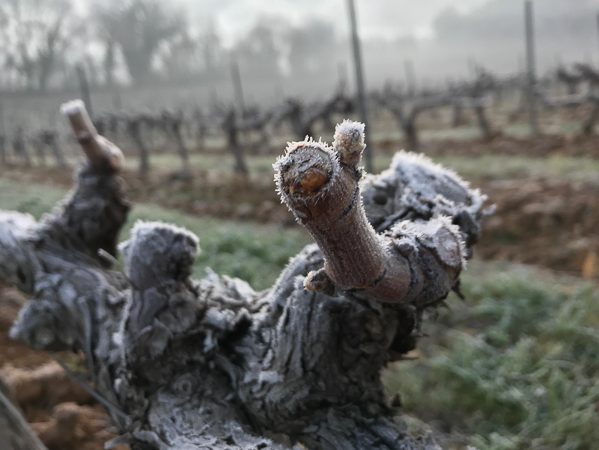
Jean-Marie Quef said that last year’s March frost caused upwards of 40% loss in overall volume at Domaine de l’Amaurigue. Photo courtesy of Domaine de l’Amaurigue
Domaine de l’Amaurigue is one of the properties where prominent budburst had occurred. This estate has hit by the March 2020 frost, causing a loss of 30 to 40% of production. Quef explained that there is often a greater yield the year after frost damage so he was hopeful that the 2021 harvest would make up for the losses of the 2020 harvest. This clearly will not happen.
Finally, in the region that produces world’s most coveted rosés, Grenache is the lifeblood in the typical blend of grapes. Except for Bandol and Bellet, two of Provence’s nine appellations, one is hard-pressed to find a rosé without a significant amount of Grenache in it. It contributes to the pale color, fruit forwardness, and structure of these dry rosés, characteristics that help to define the global gold standard of pink wine. Woefully, Grenache is the among the very first varieties to have bud burst and, therefore, the losses are expected to be great.
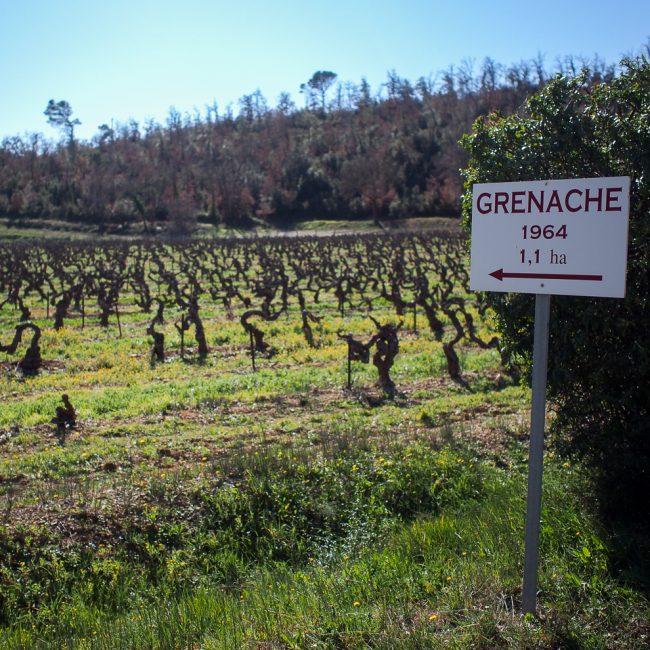
Jean-Marie Quef said that last year’s frost caused upwards of 40% loss in overall volume and 50 to 60% loss in volume of Grenache at Domaine de l’Amaurigue. Photo by W.T. Manfull
“Grenache will be the most affected, “Bru concurred, adding that this grape variety is among the earliest of the varieties grown in Provence to bud. By contrast, Cabernet Sauvignon which is one of the main varieties grown at Château Vignelaure, is more resilient, according to Bru.
“It’s clearly going to affect encépagement,” Bru predicted. He added that it is too early to tell for certain, but it is likely that blends may be different and, although not at Vignelaure, other wineries may choose to drop certain cuvées.
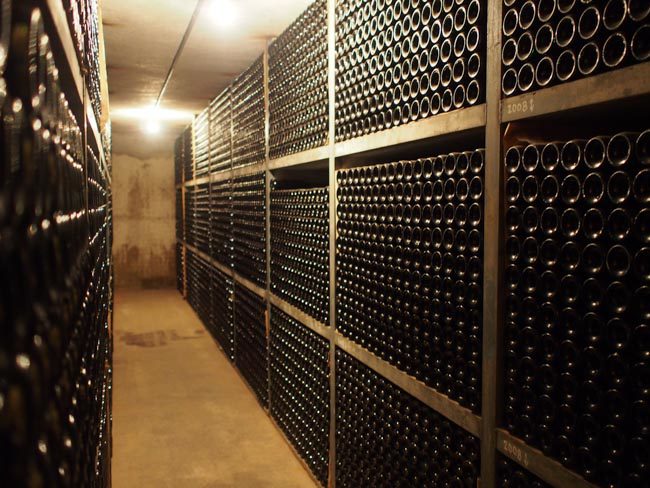
Although upwards of 90% of wine production in Provence is devoted to rosé, a surprising large number of estates place significant emphasis on red and white production. In the three main appellations of Provence, approximately 7% of production is red wine and about 4% is white wine. “I have a cellar full of reds and whites,” Bru said. (The same could be said of several of the estates mentioned in this article.) Photo by W.T. Manfull
“The greatest impact will be on rosé,” Bru said. “There will be a significant volume change.”
Bru underscored that the impact of a drop in rosé production will be felt immediately by many producers because rosé typically ships right away and provides immediate cash flow. Château Vignelaure produces all three colors (as well as a marc and late harvest wine) so the estate is not dependent on rosé like many other wineries in Provence. A quick glance at the Vignelaure website shows that his stock of red wine (for public sale) goes back to 2004.
What to Do to Protect the Vines from Frost?
As can be seen in photos that have accompanied the news of this frost, many vignerons – and their teams, extended family, and friends – used fire or water to help protect the vines. Heating the air in the vineyard dates back 2500 years or so to when the Romans lit piles of dead vines to protect their vines from the effects of frigid temperatures. Paraffin-candles are widely used and create an ethereal scene, making the onlooker momentarily forget the reason all those candles are carefully arranged throughout the vines. Fossil-fueled heaters are not widely used any more. Often wind machines and sprinklers are used in combination. Properly used, these sources of heat can raise the temperature several degrees. (Needless to point out, air pollution and uncontrolled fire are serious drawbacks to some forms of heat and the candles are surprisingly expensive.)
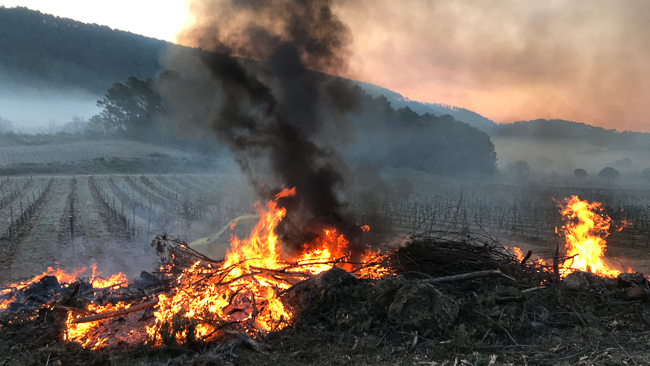
In an effort to protect the vines at Domaine de l’Amaurigue from frost damage in March 2020, large fires were built. Photo courtesy of Domaine de l’Amaurigue
Though a process I confess that I don’t fully understand, overhead sprinklers are widely used to protect the vines through “fusion.” Apparently, when the water changes from liquid to solid (that is, ice), it releases heat and increases the temperature of the tissues in the grapevines. However, in practice, using these rotating sprinklers is not like watering one’s lawn and can cause more damage than the cold temperatures if not used correctly. A lot of water is necessary, a drawback for many vineyard owners.
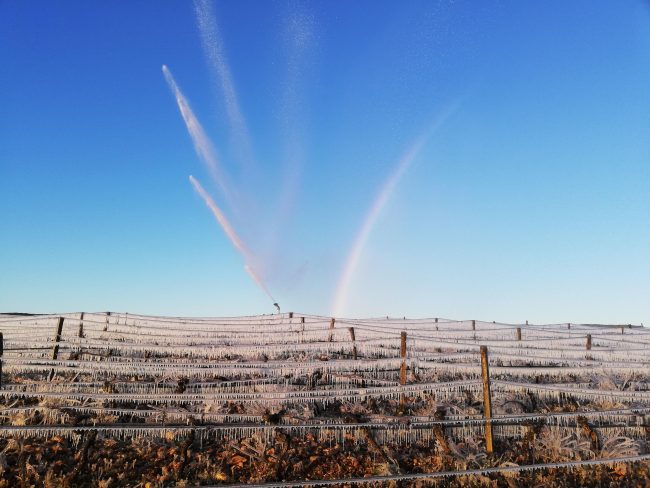
At Château Vignelaure, rotating sprinklers spray water on the vines on 0.5 hectares of the 55-hectare property. Photo courtesy of Philippe Bru
It seems that many of the people with whom PWZ spoke have come to the conclusion that these weather extremes are increasingly occurring and may be an inevitable part of climate change. Echoing this sentiment, Jeany Cronk wrote: “It appears that these conditions are becoming more common, and we cannot assume this to be a once or twice in a generation event anymore and must take action accordingly.”
Adopting different approaches to pruning to retard the bud break was mentioned by almost everyone. It is interesting to note that Miglio had not yet pruned his Grenache vines so his buds that not burst yet when the frost hit. Others had “pruned very long,” usually part of a “double-pruning” approach
Other more long-term solutions include more strategic planting of certain varieties. It is widely known that cold air flows downhill, so a mid-slope position is a good choice for early bud burst varieties (if you have the luxury and permission to expand your vineyard!).
Planting hybrids may be another option. Elizabeth Gabay MW said that at least one very established estate in Provence is considering that approach. French researcher have developed four new “supergrapes,” which are resistant to fungal diseases thus enabling a reduction of pesticides. “[The] appellation last year gave permission for a small percentage of hybrids.”
Planting climate-change varieties is yet another option. Following a 2018 ruling by the Institut national de l’origine et de la qualité (INAO), a new category of grape varieties – for climate and environmental adaption – is now permitted under AOC rules. New plantings cannot exceed 5% of the land or 10% in the blend of the cuvée. (More on all these new grapes in an upcoming article.)
The Emotional Impact
Being a winemaker is not as romantic as a Peter Mayle novel might suggest. I learned this early on from an unexpected conversation with the winemaker and owner of a highly regarded, very small estate in Provence. We were tooling around, stopping by wineries we had on our long list to visit while on vacation. As we approached the tasting room of the first winery on our list, we could see that it appeared to be closed. We rang the bell because it is often the case that the tasting rooms of such small operations are run by the winemaker or some member of the family who only shows up when the bell rings. A handsome, svelte man came around and said that he was closed. He began telling us why he was closed and, as he spoke, we learned that he was the owner and winemaker, and that he was distraught.
Just a few days earlier, a freak hail storm had destroyed his entire crop of red grapes and most of the white grapes. I didn’t need to speak fluent French to understand that this man was devastated by the loss of his livelihood for the year. He appeared to be in shock, denial, disbelief. He had been rubbing his arms as he spoke with us and eventually showed us how they were covered by a rash of red bumps. He soon insisted that we come in for a tasting and I felt like we had been invited to step into his life, and the intimate vicissitudes of a winemaker. For those who make wine, there’s but one chance each year and a lot rides on that chance. For this man, his chance had been pummeled by Mother Nature, the same source that usually provides the sustenance for him and his family. In the end, I think there was a shrug of the shoulders as if to say, “c’est la vie.” Life would go on. We made no more stops on our way home that afternoon as that man gave us all the wine we needed that day.
Jean-Marie Quef shared sentiments about this devastating frost that made me think of that winemaker all those years ago. “It’s demoralizing,” he said, “for me and for all the workers because the same work has to be done just as if you were expecting a harvest.” I pictured Quef and his team out in the vines, pruning, tending to the soil, tending to the vines, and picking what’s there, all the while knowing that a great vintage will not follow.
Miglio, who practices biodynamic viticulture, follows the lunar calendar which, he said, had predicted a cold spring. “Three times in history, there have been severe frosts in May, ” he said. With Saturn dominating, there is still some risk.
The character of this millisime will be defined by the frost, Bru reflected. However, the last line in his email to me read: “On va y arriver et je reste confiant dans l’avenir !!” That is, we will get through this and I remain confident in the future.
Editor’s Note: A report on the impact of this frost in Southern Rhône vineyards to follow.

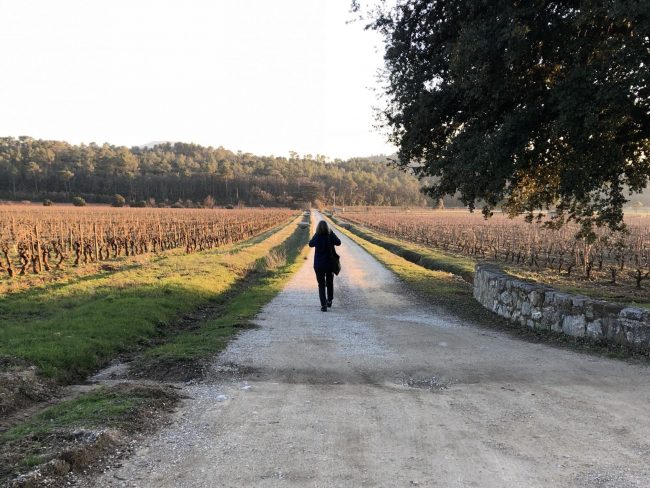
As much as we delight in the wonder of Mother Nature, she wields the power and this time it was a crushing blow to this iconic wine region. It has been the area most visited in my small number of travels abroad. Fabulous weather, giant sunflowers coninusll turning their faces to the sun, the heady fragrance of lavender wafting on a warm breeze, delicious food, stunning scenes, fragrant herbs, vibrant people and countless opportunities to share memorable conversations accompanied by stunning wine that has come to incorporate all the things I’ve mentioned into spectacular wines you can hold in your glass by the stem as one swirls images and memories of all the above can be recalled slowly with each savored sip.
Patti,
Your lovely thoughts warmed the frosty scenes I have just written about. As Philippe Bru said, “we will get through this….”
Just when we thought better days were around the corner. My heart goes out to all our hard working and hard hit producers. Thanks for the article Susan.
Keep them all in your heart….it’s the next corner, I’m sure! Thanks for the note!
What a detailed technical account of a sad situation. I remember visiting the Rhone in the Spring ih the apple trees in bloom and will read with interest your blogpost on that region.
Thanks, Lisa. I just read that the President of the National Association of apples and pears said that stone fruits like peaches, nectarines, and apricots will be “rare” on the shelves this year. 🙁